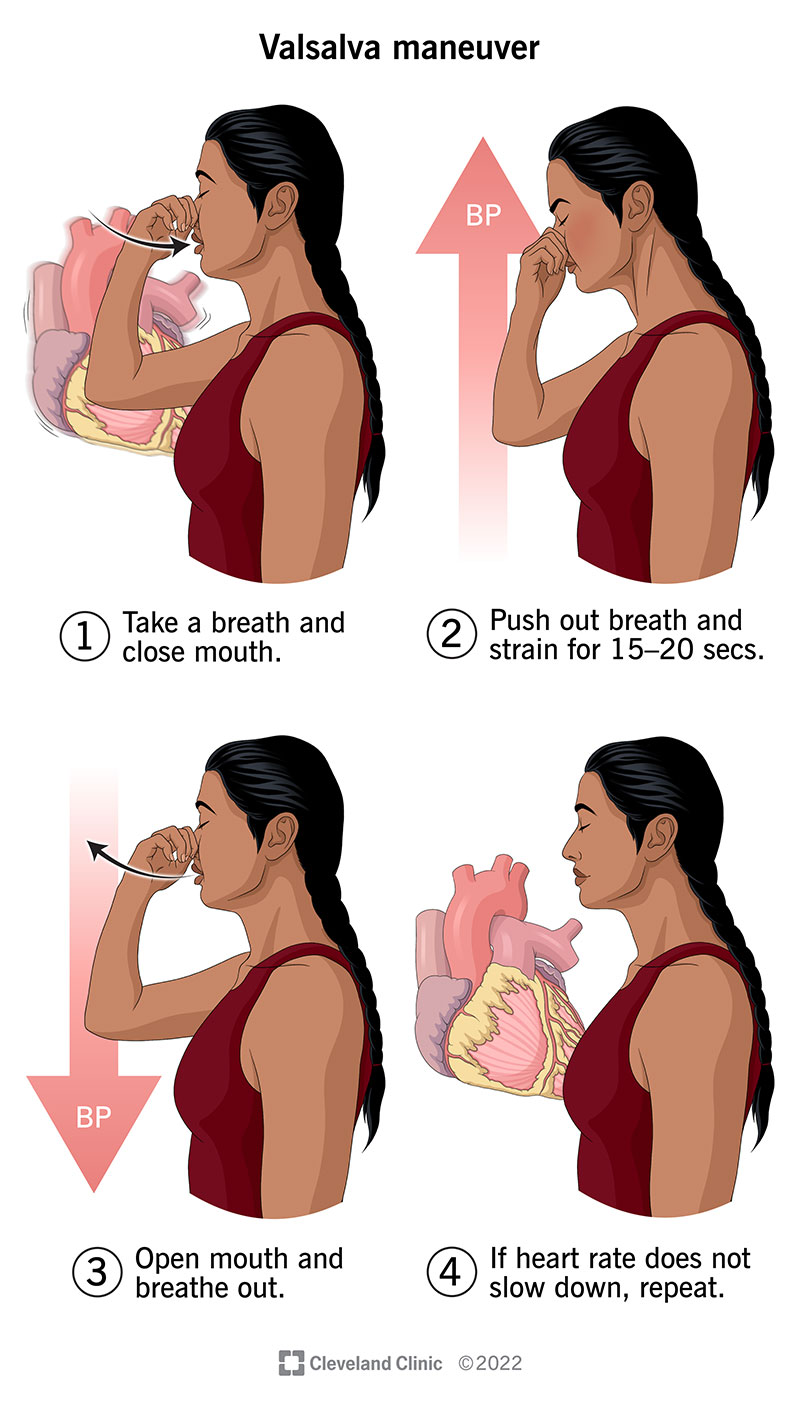The Valsalva maneuver is a drug-free way to quickly return an abnormal heart rhythm to normal. It may work for specific types of fast heart rhythms, and it doesn’t work every time. If the Valsalva maneuver fails, you’ll need cardioversion to get your heart back into a normal rhythm.
Advertisement
Cleveland Clinic is a non-profit academic medical center. Advertising on our site helps support our mission. We do not endorse non-Cleveland Clinic products or services. Policy
The Valsalva maneuver is a quick, noninvasive method for a fast heart rhythm called supraventricular tachycardia (SVT). It’s sometimes the first choice of treatment before trying medicine or another procedure to get your heart rhythm back to normal. To do the Valsalva maneuver, you push air out, but with your nose and mouth closed (like having a bowel movement).
Advertisement
Cleveland Clinic is a non-profit academic medical center. Advertising on our site helps support our mission. We do not endorse non-Cleveland Clinic products or services. Policy
You should do the Valsalva maneuver after your provider gives you instructions. They’ll also know if you have the type of abnormal heart rhythm that responds to this maneuver.
Your healthcare provider can use the Valsalva maneuver to diagnose you or treat you. The Valsalva maneuver can:
Because the Valsalva maneuver increases pressure in your eyes and belly, you shouldn’t do this maneuver if you have retinopathy (a problem with blood vessels in the retina of your eye) and intraocular lens implants in your eyes, such as after cataract surgery.
You need to be careful with the Valsalva maneuver if you have:
Advertisement

Your healthcare provider may give you a mouthpiece that connects to a device that measures pressure. You may need to blow into the mouthpiece to make a plunger in the device float and reach a certain level. When making a diagnosis, your provider will want to see a pressure of 40 mm Hg during the Valsalva maneuver.
Two versions of the Valsalva maneuver can help with supraventricular tachycardia (SVT):
If the Valsalva maneuver is successful, which happens 5% to 20% of the time, your fast heart rate will slow down in about one minute. If it doesn’t stop your supraventricular tachycardia after three tries, your healthcare provider will proceed with the next steps in treatment. These steps may include carotid massage, medications or electric cardioversion depending on your symptoms, vital signs and the type of supraventricular tachycardia.
The Valsalva maneuver is a fast, drug-free way to stop a supraventricular tachycardia (SVT). If it works, you can avoid medications or cardioversion.
Most people can do the Valsalva maneuver safely and not have complications.
Side effects don’t usually happen with the Valsalva maneuver, but some people experience:
The recovery time for the Valsalva maneuver itself is very quick. However, if it didn’t work and you’re still having supraventricular tachycardia (SVT), your healthcare provider will need to do other maneuvers or perform electrical or medication-based cardioversion.
Contact your provider if they taught you the Valsalva maneuver and told you to use it for SVT and it didn’t work. They can help you get your heart back into a normal rhythm with medicine or electrical cardioversion.
Advertisement
The Valsalva maneuver can be a useful tool in getting your SVT back to a normal heart rhythm. However, since it doesn’t work every time, it’s best to have a plan for your next step. Talk with your healthcare provider about what they recommend.
Advertisement
When your heart rhythm is out of sync, the experts at Cleveland Clinic can find out why. We offer personalized care for all types of arrhythmias.

Last reviewed on 06/09/2022.
Learn more about the Health Library and our editorial process.